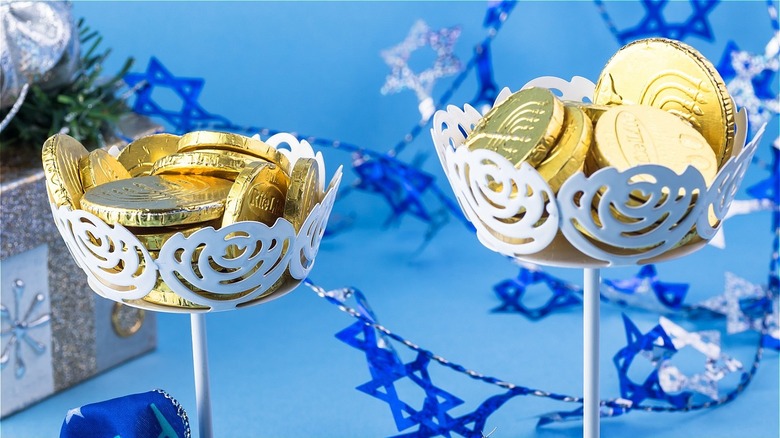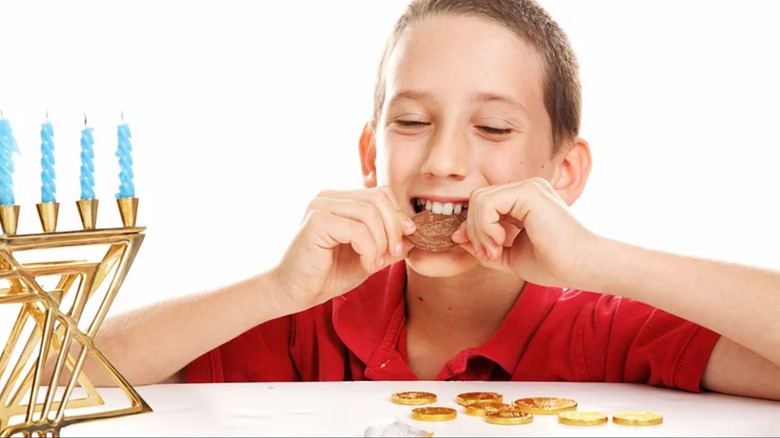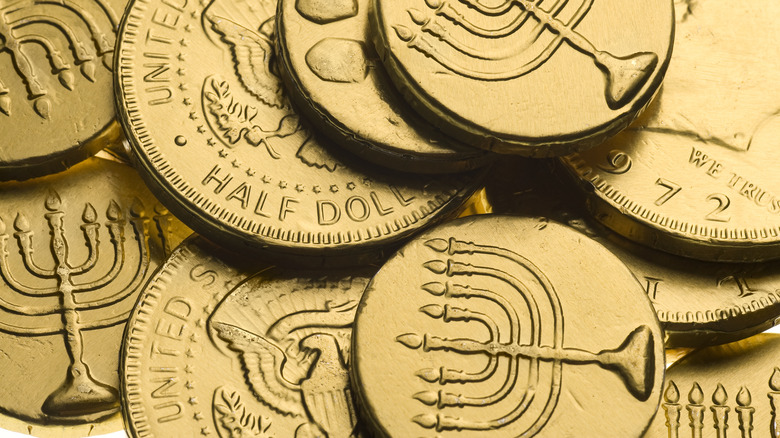The Real Reason People Eat Chocolate Gelt On Hanukkah
Christians get plenty of chocolate during their holidays, whether it's chocolate Easter bunnies or sweet Santa-shaped stocking stuffers on Christmas morning. The Jewish observance of Hanukkah has risen in prominence in the U.S. precisely because it's so close to the Christmas holiday and it's nice for non-Christians to have some kind of counterpart to the Jesus and Santa celebration that is so dominant in American culture. Even the practice of gift-giving over Hanukkah is a relatively recent one, adopted in response to the influence of Christmas. One way in which Jews aren't copying Christians, though, is when they give foil-wrapped chocolate coins called gelt over the eight-day festival of lights. Chocolate may be a Christmas thing, but chocolate gelt is uniquely rooted in Hanukkah history.
Chocolate gelt has various connections to Hanukkah. "Gelt" is Yiddish for money, and coins in particular have been associated with Hanukkah ever since the holiday's origin. Hanukkah celebrates the miracle of the one-day supply of oil that lasted for eight days and kept the menorah lit in the Holy Temple in Jerusalem after the Jewish victory over the occupying Syrian-Greeks. According to Reform Judaism, the very celebration of the temple's re-dedication (the word "Hanukkah" translates to "dedication") may have been spent distributing coins obtained as the spoils of battle either to soldiers or to their widows or orphans. The Hasmonean dynasty, descendants of the Maccabees who defeated the Syrian-Greeks, minted coins in recognition of their newfound independence which became the reason for Hanukkah celebrations.
Chocolate gelt stems from the tradition of giving children real money during Hanukkah
In a practice dating to the sixth century, Jews would offer coins as charity to poor members of their faith because the Talmud required that all Jews, regardless of means, obtain the oil and candle supplies needed to celebrate Hanukkah. In Europe in the 18th century, Hanukkah gelt became associated with the practice of paying rabbis who traveled to remote villages to give religious instruction. This came about because the Hebrew word Hanukkah, besides meaning "dedication," is close to the word for "education." Children would receive money during Hanukkah, too, as a reward for studying the Torah, or as an opportunity to learn the value of money. Often, parents required their children to give a portion of their gelt to charity.
The transition from real coin to chocolate occurred in the U.S. in the 1920s. Loft's candy company came out with chocolate coins wrapped in silver foil and marketed the treats as chocolate gelt for Hanukkah. Today, chocolate gelt wrapped in silver or gold foil remains a part of the Hanukkah tradition. The chocolate tends to be hard and not very tasty; nevertheless, it is an important part of the joy of Hanukkah. Even those children who aren't tempted to eat the not-so-gourmet chocolate may gamble it away in a game of dreidel.
All that glitters is not foil-wrapped candy
Not all Hanukkah gelt is made of cheap, flavorless chocolate. These days, a wide variety of chocolate coins is available, with some of this gelt being fair trade, organic, small-batch, artisanal, bean-to-bar, or any of the numerous other adjectives beloved by upscale foodies. Still, no matter how chichi the chocolate, the gift is nowhere near as lavish as if the gold coins were real ones, Nearly a decade ago, Money calculated the value of the coins by volume (not weight, because gold is, of course, much heavier than chocolate) and came up with a value of nearly $7,000. As the current market price has risen quite a bit since 2014, this hypothetical value is now up to almost $13,000.
Now, very few bubbies and zaydes can spend quite that lavishly at Hanukkah time, but still, many grandparents do gift the kids with actual cash instead of (or in addition to) chocolate coins. Some will stick with a formula based on the age of the child in dollars, while others may be able to donate more generous amounts ranging from $20 to $50 or even higher. This may well have to do with the number of grandkids as well as the size of the bank account, though, since if you've been generously endowed with the former and not quite so blessed in the latter area, gifting real gelt can add up to a hefty sum.


